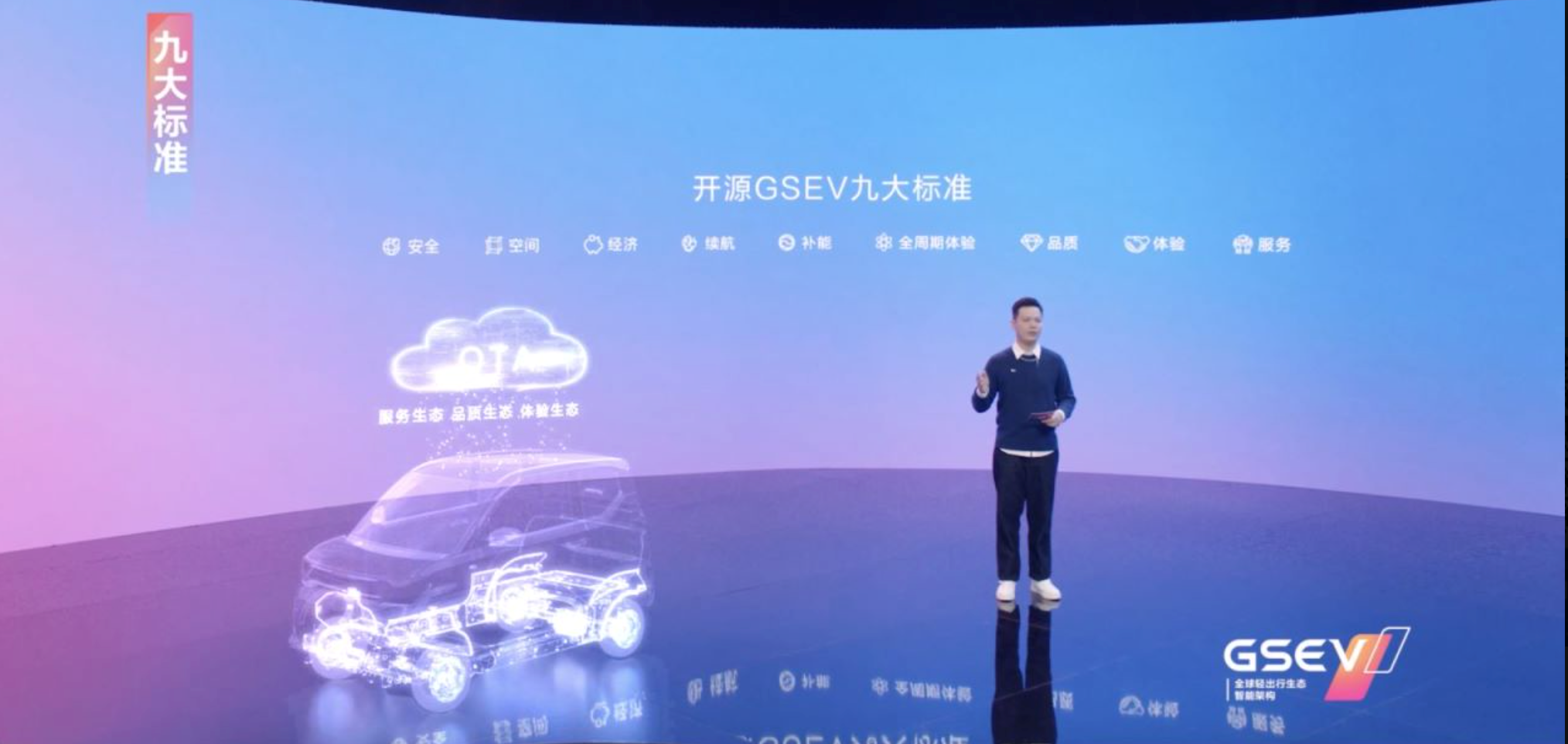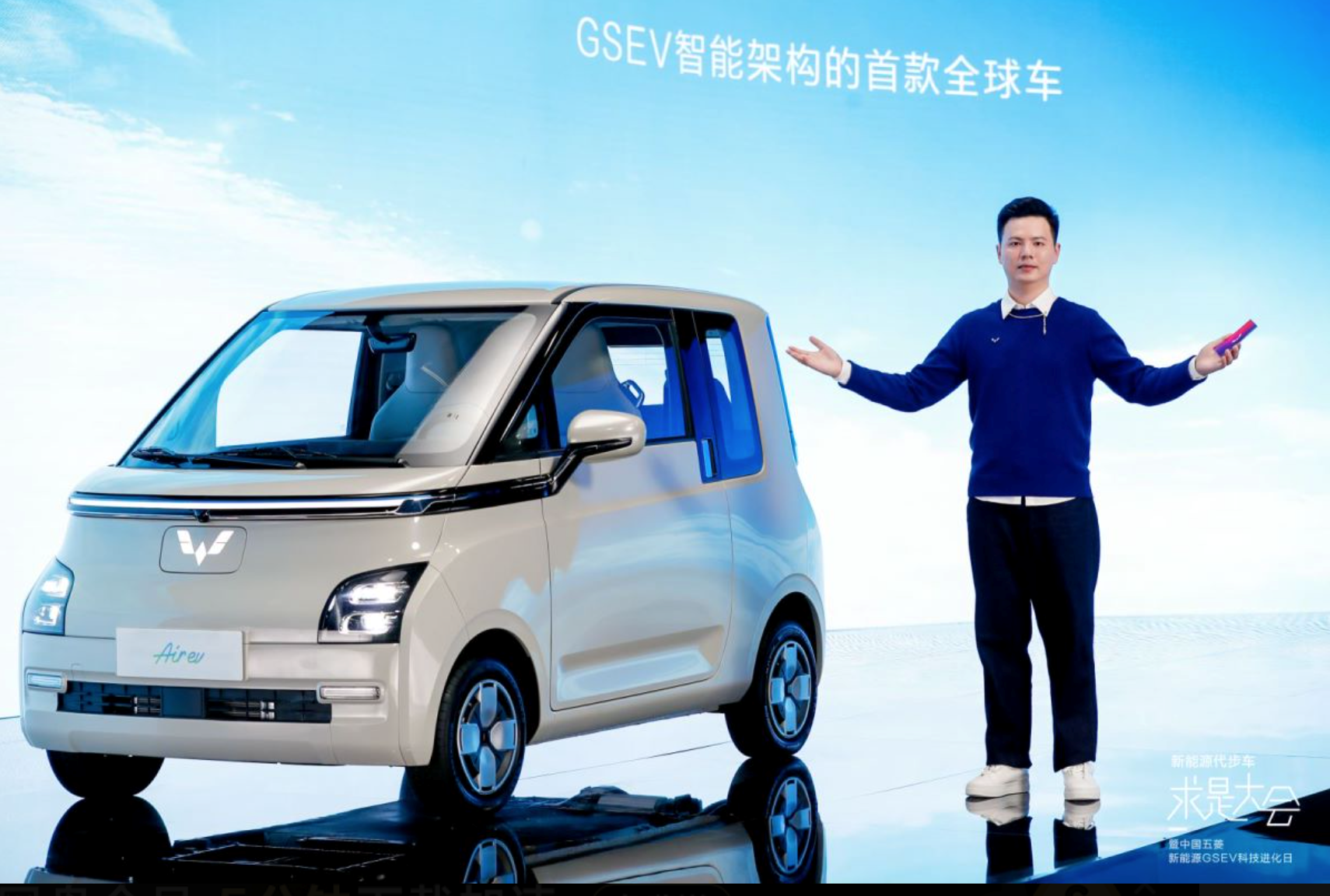Author | Zhu Shiyun
Editor | Qiu Kaijun
When the 2020 Wuling Hongguang MINI EV was launched, it was hard to imagine that the outdated A00-level pure electric market could once again see the prosperity of millions of vehicles. Now, Wuling has not only sold one million A00 pure electric vehicles, but also released an upgraded version of MINI EV–Air EV.
Many people say that Wuling is also losing money while making reputation. In fact, they clearly state that they can make money by producing the Hongguang MINI EV.
On November 3, China’s Wuling New Energy released the GSEV intelligent architecture, an upgraded version of the GSEV architecture used in the Hongguang MINI EV, and the first global car built on this architecture, the Air EV.
At the same time, Wuling also released the “Nine Standards” of Hongguang MINI EV: safety, space, economy, endurance, energy replenishment, full-cycle evolution, quality, experience, and service, and announced technology open source, hoping to work with all parties in the industry chain to expand the market for commuting vehicles.
The intention is not only to make money, but also to allow everyone to make money together.
Crossing the break-even point with a million vehicle scale
“At the current stage, our product has no problem and is no longer losing money.”
The person in charge of Wuling New Energy explained the evolution relationship from MINI EV to Air EV: “When the Hongguang MINI EV was launched in 2020, it needed to maximize the convenience of users experiencing new energy commuting vehicles. Therefore, in the initial stage, we priced it based on a comprehensive evaluation of these factors, and the cost at that time was basically slightly in a loss to open up the market.
However, from the initial stage to now, our sales have increased and have been recognized by users. The supply chain is also gradually localized. After the scale is increased, the cost of the entire supply chain is under control. So, based on the first-generation product, we have made some upgrades to address user pain points and needs.”
Since its launch in July 2020, the cumulative sales of Wuling MINIEV have exceeded 900,000 units. Together with the development of the GSEV architecture for the Baojun E100 and E200 models, which began in 2014 and saw the launch of the first model, the Baojun E100, in 2017, the global small electric vehicle (GSEV) platform by Wuling New Energy has produced more than one million electric vehicles and demonstrated the company’s understanding of the Chinese commuter vehicle market.
Wuling New Energy found out that Chinese users travel an average daily distance of no more than 30 kilometers at a speed of not more than 30 kilometers per hour, and more than 70% of the roads are fourth-class highways with a design speed of not higher than 40 kilometers per hour. Therefore, Wuling New Energy believes that a product with the highest resource utilization rate needs to be extremely economical in terms of road occupancy, takes up minimal parking space, has low energy consumption, and can cover the vast majority of users’ travel scenarios.
Wuling is not the only company that discovered this market demand. In fact, the North-Benz EC series, Zhidou, and Chery QQme all had a strong presence in the A00 market segment in the past. However, due to the rapid decline in the market in 2018, the market share of A00 pure electric passenger cars dropped from nearly 70% to less than 30%, and large-battery long-endurance became the core pursuit of pure electric products.
It wasn’t until 2020 when Wuling MINIEV “redesigned” the A00 level pure electric commuter vehicle.The GSEV architecture pursues the principle of “good driving, good parking, and good energy saving” for commuting vehicles. In terms of chassis design, the GSEV architecture adopts a “low center of gravity, large kingpin inclination angle, and rear-wheel drive” design, which maximizes the front-to-rear weight ratio of the whole vehicle and solves the problem of vehicle stability in bends for micro-cars.

The GSEV architecture has self-developed and proprietary electric power steering, which increases the steering angle and reduces the turning radius in a compact layout. A three-step response bandwidth is established to ensure millisecond-level response and linear experience, making it easy for ordinary people to make U-turns.
In addition, as a commuting vehicle architecture, the GSEV has extremely high driving efficiency, with a minimum power consumption of 8.8 kWh per hundred kilometers and only 5 cents per kilometer.
It has received market recognition after being developed from scratch according to user demands and the unique characteristics of micro-cars.
According to the data released by the China Passenger Car Association, among the top 15 new energy passenger cars in terms of sales in 2021, 8 are A00-level products, including the Hongguang MINIEV, Chery eQ, Benben EV, Ora Black Cat, Kairuiwei CLEVER, and Lengpao T03, etc.
Pursuing Profit in Light Travel
Although it has achieved a balance between revenue and costs with a million-unit scale, the cost pressure from upstream has always been a dilemma between Wuling’s commuting vehicles and profitability.In March of this year, SAIC-GM-Wuling announced that due to the sustained and significant upstream raw material price increases and other factors, the official guide prices of Wuling Hongguang MINI EV series, Wuling Nano EV, and Baojun KiWi EV models would be adjusted, with an increase ranging from 4000 to 8000 yuan. After the price adjustment, the entry-level price of the Hongguang MINI EV series has risen from 28,800 yuan to 32,800 yuan, an increase of nearly 14%.
Meanwhile, the prices of Chery Little Ant and QQ Ice Cream have been adjusted by 3000-6000 yuan, while the new Ora Black Cat prices have risen by 8000-18000 yuan. Black Cat and White Cat models have even been completely discontinued later due to cost pressures.
For micro cars, “price increases” have always been limited in space, whereas upstream raw material price increases show no signs of stopping.
Compared to the end of 2020, the price of lithium carbonate has increased by more than ten times and shows no signs of slowing down.
A senior advisor from an Australian lithium mining company, known as “Mr. Sydney”, predicts that the core raw material for lithium carbonate, spodumene, may reach 8000-10000 US dollars/tonne in 2026, corresponding to a price of about 600,000-800,000 yuan/tonne for lithium carbonate. This means that the cost of power batteries may increase by 8.6%-31.5%. This “hard inflation” is difficult for battery companies, vehicle manufacturers, and consumers to bear.
To cope with this, Wuling will continue to expand its economies of scale through technology open source.

The nine standards recently released by Wuling New Energy involve services, manufacturing quality, and cloud data. Wuling hopes to promote the sustainable development of the new energy sharing ecosystem through technical openness and collaboration with more partners, and become a major player in the new energy sharing vehicle market.
On the other hand, there is an effort to expand the product line. The above-mentioned responsible person stated that the lightweight travel ecosystem concept will be integrated into all Wuling new energy products, without any restriction on price, size, and function. “We have products that are economical, and we also have products that are intelligent, satisfying the travel needs of different users.” Air EV is a smart sharing vehicle with the GSEV intelligent architecture, which has features such as cloud-vehicle synchronization and cloud-empowerment. Among them, the GSEV intelligent architecture cloud system integrates more than 200 AI intelligent algorithms, carries out real-time verification and judgment of vehicle operation data at the rate of 2 seconds per time through cloud computing, can identify vehicle faults and safety risks 7-30 days in advance, and initiates proactive responses to the disposition of the vehicle. Currently, the system’s relevant warning accuracy rate has exceeded 90%.
On the vehicle side, the centralized electronic electrical architecture of the GSEV architecture has high scalability and evolvable capability, and supports automatic parking, remote parking, memory parking, and exploratory parking.
“Next year, we will launch a product for multi-person travel, and another larger and more intelligent product, both of which are integrated with the concept of the lightweight sharing ecosystem.” The responsible person for the launch stated.# 2022 年 8 月,Air ev
In August 2022, Air ev, as the first Chinese new energy vehicle to enter the Indonesian market, officially began production. The standard version of the new car with a range of 200 km is priced at 238 million Indonesian Rupiah, while the long-range version with a range of 300 km is priced at 295 million Indonesian Rupiah, equivalent to approximately 110,000 to 135,000 yuan.
–END–
This article is a translation by ChatGPT of a Chinese report from 42HOW. If you have any questions about it, please email bd@42how.com.
